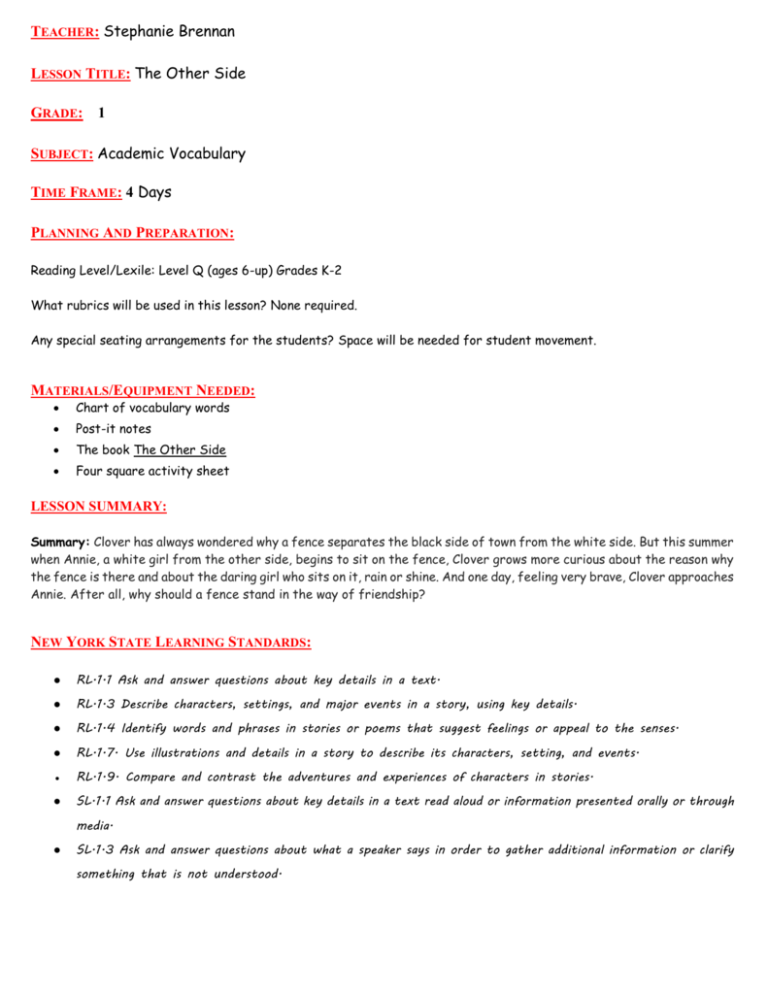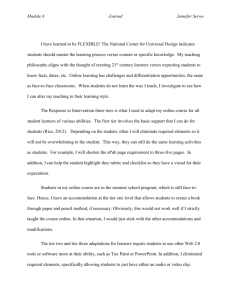Lesson Plan (stranger in the woods)
advertisement

TEACHER: Stephanie Brennan LESSON TITLE: The Other Side GRADE: 1 SUBJECT: Academic Vocabulary TIME FRAME: 4 Days PLANNING AND PREPARATION: Reading Level/Lexile: Level Q (ages 6-up) Grades K-2 What rubrics will be used in this lesson? None required. Any special seating arrangements for the students? Space will be needed for student movement. MATERIALS/EQUIPMENT NEEDED: Chart of vocabulary words Post-it notes The book The Other Side Four square activity sheet LESSON SUMMARY: Summary: Clover has always wondered why a fence separates the black side of town from the white side. But this summer when Annie, a white girl from the other side, begins to sit on the fence, Clover grows more curious about the reason why the fence is there and about the daring girl who sits on it, rain or shine. And one day, feeling very brave, Clover approaches Annie. After all, why should a fence stand in the way of friendship? NEW YORK STATE LEARNING STANDARDS: ● RL.1.1 Ask and answer questions about key details in a text. ● RL.1.3 Describe characters, settings, and major events in a story, using key details. ● RL.1.4 Identify words and phrases in stories or poems that suggest feelings or appeal to the senses. ● RL.1.7. Use illustrations and details in a story to describe its characters, setting, and events. ● RL.1.9. Compare and contrast the adventures and experiences of characters in stories. ● SL.1.1 Ask and answer questions about key details in a text read aloud or information presented orally or through media. ● SL.1.3 Ask and answer questions about what a speaker says in order to gather additional information or clarify something that is not understood. SHIFTS IN RELATION TO THE COMMON CORE STANDARDS: This lesson incorporates all of the following shifts demanded by the Common Core State Standards: Staircase of Complexity, Text-based Answers, and Academic Vocabulary. Academic Vocabulary: Isabel Beck, Bringing Words to Life, categorizes vocabulary into 3 tiers when considering which words need the most instructional attention. Beck suggests that students will benefit the most academically by focusing instruction on the Tier 2 Vocabulary Words. Tier 2 words are likely to appear in texts across content areas, essential for understanding this text. Tier 1 Vocabulary *Tier 2 Academic Vocabulary Tier 3 Vocabulary Basic vocabulary that rarely High-frequency, multiple meaning vocabulary - Low-frequency, require instructional focus words that appear with high-frequency, across context-specific vocabulary - (door, house, book) a variety of domains, and are crucial when frequency of these words is using mature, academic language (coincidence, quite low and often limited to reluctant, analysis) specific fields of study (isotope, reconstruction, Buddhism) fence yonder stare safe free polite far stretched segregation brave SEQUENCE OF LESSON ACTIVITIES: Day 1: Gather students on the rug in the classroom. Read and introduce the book The Other Side for enjoyment. Day 2: Meeting with students on the rug, talk about illustrations, characters, setting, problem in story, and solution in the book The Other Side. Introduce Tier 2 vocabulary words that are listed on the chart. While using multiple copies of the book The Other Side, students will look for the Tier 2 vocabulary words marking with a post it note. 2 Day 3: Re-introduce and discuss Tier 2 vocabulary words with students on rug. Teach students the actions for each word. Have students brainstorm movements. Students find a personal space in the room to begin movements. Read the book The Other Side while students are using music and movement to demonstrate their knowledge of the words. Day 4: Describe “Four Square” activity to students while gathered on the rug. Students will complete “Four Square” vocabulary activity individually. This activity requires student to choose one vocabulary word that they have learned from the book The Other Side. Students will identify each word, define the meaning use the word in a sentence, and draw a picture to correspond with the word. TEXT DEPENDENT QUESTIONS: C= central ideas/general ● What was the story about? understanding: ● Why was the book titled, The Other Side? D= key details: ● How did the girls feel on each side of the fence? ● Did the girls care about what their friends said when they were playing together? ● V= vocabulary: S= text structure: Did the girls listen to their mothers and their opinions? ● What does it mean to look over yonder? ● Why does the author use the word brave? ● How does the author show that the girls feel free? ● How does the author develop the girls’ friendship throughout the story? ● AP= author's point of view: ● What does the author want us to know about segregation? ● Is the girls’ point of view the same as their mother’s point of view? REFLECTION: In preparing for these lessons using the book The Other Side and focusing on academic vocabulary, I carefully selected Tier 2 vocabulary words that I felt were critical to the students’ understanding of the text. Before participating in this professional development cadre, I hadn’t focused on the vocabulary in such a way. Understanding Common Core shift number six where students are asked to build vocabulary that is needed to access grade level complex texts, I now have a better understanding of the importance and the value of including this in my lessons each day. Additionally, using the kinesthetic approach enhances student learning and is a much more engaging way to learn vocabulary. 3 I chose the book The Other Side based on my experiences in these professional learning sessions. Actually participating with Susan Griss during our course and learning the value of kinesthetic learning led me to believe that I can provide a deeper understanding of vocabulary and incorporate the Common Core shifts into my first grade classroom. 100213 4







